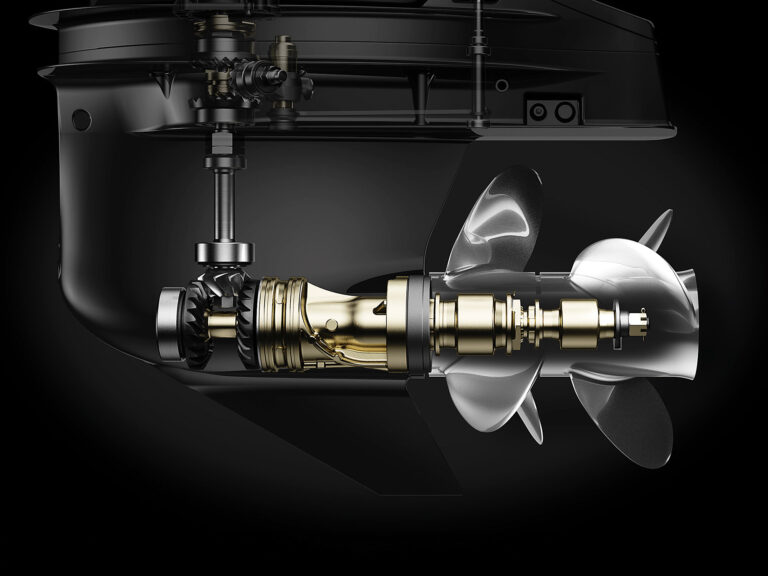
The steps to apply anti-fouling bottom boat paint are different for brand-new boats, as opposed to older boats needing a recoat, because new boats need the wax used to free them from the mold removed. Harnessing our own experience and expert input from Margo Hunt, support manager at Pettit Marine Paint, we created this boat primer for you. Know that the process for bottom painting a boat is the same regardless of the product brands you choose. The first tip is to wear a respirator as well as protective eyewear, gloves and clothing when performing these tasks.
How to Bottom Paint a Boat
Step 1: Preparation
Dewax with no Volatile Organic Compound (VOC): The mold-release wax must be removed from new hulls. Apply Pettit’s Bio-Blue Hull Surface Prep 92 with a short-nap roller to a 5-by-5-foot area. Scrub with a Scotch-Brite pad, wipe with a wet sponge to remove residue, and rinse the sponge and surface often, changing the rinse water often.
Dewax with VOC: Tried and true solvents, such as Pettit’s Dewaxer D-95, work too. Apply a wet coat in a circular motion liberally and wipe dry with a clean cloth. Change cloths often, lest you reapply the wax you just removed. Clean at least four times to ensure complete wax removal.
Step 2: Sanding
After dewaxing, you need to give the hull some “tooth.” Sand the hull with 80-grit paper until it looks dull and “frosty.” Wipe with 120 Brushing Thinner to remove sanding dust.
Skip Sanding: Pettit’s 6998 Skip Sand Primer eliminates the need to sand because it chemically etches the hull. It’s ideal for use over vinylester gelcoats where sanding may void warranties. The typical street price is $30 to $40 per quart.
Step 3: Insurance
Some fiberglass/resin matrices can absorb water over time — often with disastrous results. Consider applying a barrier coating, such as Pettit Protect 4700/4701, if you wet-store your boat to help avoid the problem. Do this before applying the anti-fouling paint for the fiberglass boat.
Step 4: Bottom Coat
If you applied a barrier coating, apply an anti-fouling coating of your choice while the 4700/4701 is still tacky. If not, apply the anti-fouling coating, following the directions on the can.
For Older or Previously Painted Boats
If your previously painted boat’s surface is in reasonable condition, simply scrape and sand any loose or flaking areas and recoat, following the manufacturer’s directions on the can.
Why Is Bottom Paint Important?
Bottom paint is important for boats because it:
- Prevents marine growth: The main purpose of bottom paint is to prevent the growth and accumulation of organisms like barnacles, algae, and slime on the hull of the boat. Each of them can increase drag in the water, in turn reducing the boat’s speed, efficiency, and fuel economy.
- Protects the hull: Bottom paints contain compounds that protect hull material from corrosion, especially for steel and aluminum boat. Marine growth can also physically damage the hull surface over time by creating rough spots or burrowing into the surface. Bottom paint acts as a barrier to prevent this.
- Improves performance: By keeping the hull smooth and free of marine fouling, bottom paint helps the boat to move through water more efficiently. This improves the vessel’s speed, handling, fuel consumption, and overall performance.
- Extends vessel lifespans: Protecting the hull against corrosion and marine growth buildup helps extend its usable lifespan before expensive repairs or a replacement is needed.
- Ensures regulatory compliance: In many regions, bottom paints are subject to environmental regulations introduced to reduce the release of toxic compounds. Using approved antifouling coatings is important for compliance.
Do Your Boat Bottom Paint Prep Work
While properly preparing for fresh bottom paint requires some effort, it can make all the difference in the effectiveness of your paint job. By following the four key steps above, you can ensure optimal performance, efficiency, and longevity for your vessel’s hull. With a smooth, clean, and properly coated bottom, your boat will be ready to slice through the waters with ease.
FAQ
Is bottom paint necessary in freshwater?
While bottom paint is not strictly necessary in freshwater environments, many boat owners still choose to apply it as a protective measure against fouling from algae and other freshwater organisms. However, the need for bottom paint is generally less urgent compared to saltwater.
Do you have to sand before bottom paint?
Yes, sanding is an essential step when preparing a hull for new bottom paint. Sanding helps rough up the existing surface to allow for better paint adhesion. It also removes any loose, flaking paint or other debris that could prevent proper bonding.
Does a boat need bottom paint every year?
Not necessarily every year, but bottom paint does need to be reapplied periodically. The frequency depends on factors like the type of paint used, the boat’s activity level, and local fouling conditions. Many experts recommend repainting every one or two years for optimal protection.









